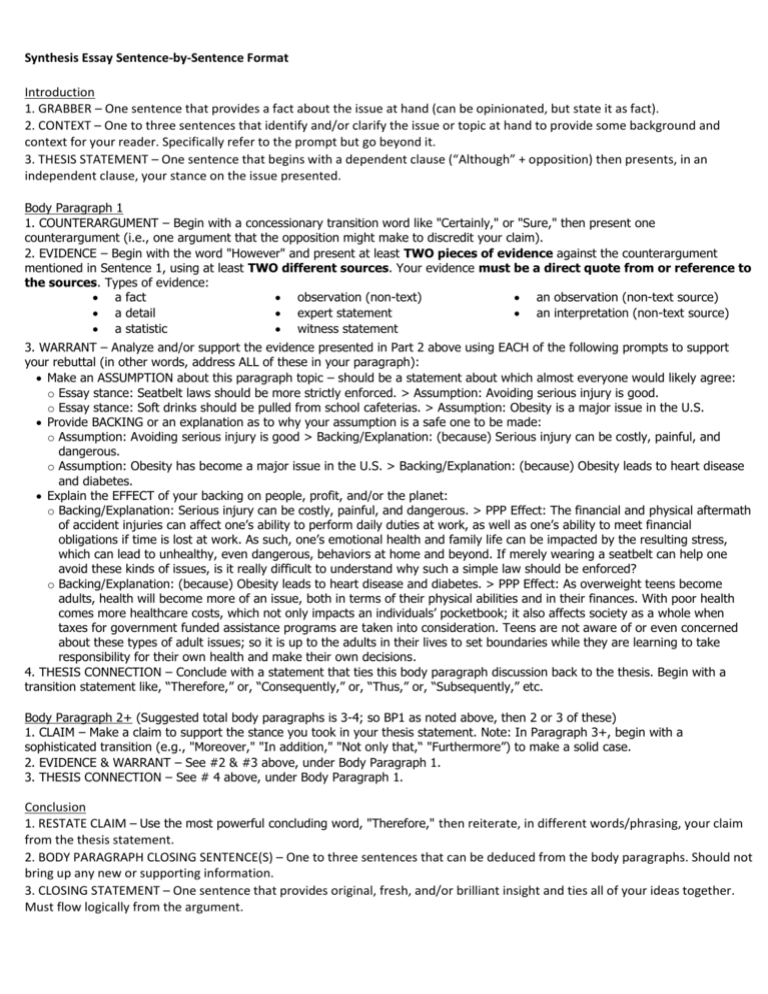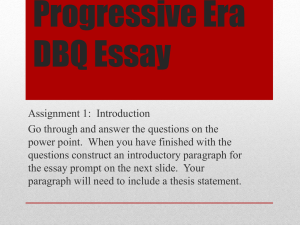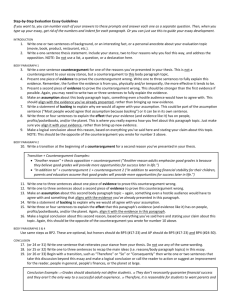Synthesis Essay Sentence-by-Sentence Format Introduction 1
advertisement

Synthesis Essay Sentence-by-Sentence Format Introduction 1. GRABBER – One sentence that provides a fact about the issue at hand (can be opinionated, but state it as fact). 2. CONTEXT – One to three sentences that identify and/or clarify the issue or topic at hand to provide some background and context for your reader. Specifically refer to the prompt but go beyond it. 3. THESIS STATEMENT – One sentence that begins with a dependent clause (“Although” + opposition) then presents, in an independent clause, your stance on the issue presented. Body Paragraph 1 1. COUNTERARGUMENT – Begin with a concessionary transition word like "Certainly," or "Sure," then present one counterargument (i.e., one argument that the opposition might make to discredit your claim). 2. EVIDENCE – Begin with the word "However" and present at least TWO pieces of evidence against the counterargument mentioned in Sentence 1, using at least TWO different sources. Your evidence must be a direct quote from or reference to the sources. Types of evidence: a fact observation (non-text) an observation (non-text source) a detail expert statement an interpretation (non-text source) a statistic witness statement 3. WARRANT – Analyze and/or support the evidence presented in Part 2 above using EACH of the following prompts to support your rebuttal (in other words, address ALL of these in your paragraph): Make an ASSUMPTION about this paragraph topic – should be a statement about which almost everyone would likely agree: o Essay stance: Seatbelt laws should be more strictly enforced. > Assumption: Avoiding serious injury is good. o Essay stance: Soft drinks should be pulled from school cafeterias. > Assumption: Obesity is a major issue in the U.S. Provide BACKING or an explanation as to why your assumption is a safe one to be made: o Assumption: Avoiding serious injury is good > Backing/Explanation: (because) Serious injury can be costly, painful, and dangerous. o Assumption: Obesity has become a major issue in the U.S. > Backing/Explanation: (because) Obesity leads to heart disease and diabetes. Explain the EFFECT of your backing on people, profit, and/or the planet: o Backing/Explanation: Serious injury can be costly, painful, and dangerous. > PPP Effect: The financial and physical aftermath of accident injuries can affect one’s ability to perform daily duties at work, as well as one’s ability to meet financial obligations if time is lost at work. As such, one’s emotional health and family life can be impacted by the resulting stress, which can lead to unhealthy, even dangerous, behaviors at home and beyond. If merely wearing a seatbelt can help one avoid these kinds of issues, is it really difficult to understand why such a simple law should be enforced? o Backing/Explanation: (because) Obesity leads to heart disease and diabetes. > PPP Effect: As overweight teens become adults, health will become more of an issue, both in terms of their physical abilities and in their finances. With poor health comes more healthcare costs, which not only impacts an individuals’ pocketbook; it also affects society as a whole when taxes for government funded assistance programs are taken into consideration. Teens are not aware of or even concerned about these types of adult issues; so it is up to the adults in their lives to set boundaries while they are learning to take responsibility for their own health and make their own decisions. 4. THESIS CONNECTION – Conclude with a statement that ties this body paragraph discussion back to the thesis. Begin with a transition statement like, “Therefore,” or, “Consequently,” or, “Thus,” or, “Subsequently,” etc. Body Paragraph 2+ (Suggested total body paragraphs is 3-4; so BP1 as noted above, then 2 or 3 of these) 1. CLAIM – Make a claim to support the stance you took in your thesis statement. Note: In Paragraph 3+, begin with a sophisticated transition (e.g., "Moreover," "In addition," "Not only that,“ "Furthermore”) to make a solid case. 2. EVIDENCE & WARRANT – See #2 & #3 above, under Body Paragraph 1. 3. THESIS CONNECTION – See # 4 above, under Body Paragraph 1. Conclusion 1. RESTATE CLAIM – Use the most powerful concluding word, "Therefore," then reiterate, in different words/phrasing, your claim from the thesis statement. 2. BODY PARAGRAPH CLOSING SENTENCE(S) – One to three sentences that can be deduced from the body paragraphs. Should not bring up any new or supporting information. 3. CLOSING STATEMENT – One sentence that provides original, fresh, and/or brilliant insight and ties all of your ideas together. Must flow logically from the argument.








